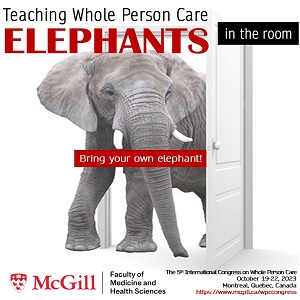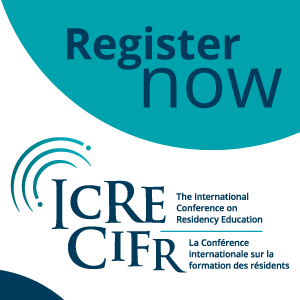Five ways to get a grip on designing medical student clerkship clinical rotations during a pandemic
DOI:
https://doi.org/10.36834/cmej.74000Abstract
During the COVID-19 pandemic, the task of preparing students for workplace-based clerkship and supporting learners’ ongoing professional identity formation became incrementally more challenging. The former design of clerkship rotations was re-challenged and revolutionized going forward, as COVID-19 accelerated the development and implementation of e-Health and technology-enhanced learning (TEL). However, the practical integration of learning and teaching activities, and the application of well-thought-out first principles in pedagogy in higher education, remain difficult to implement in today’s pandemic era. In this paper, using the transition-to-clerkship (T2C) course as an example, we outline the steps taken to implement our clerkship rotation, discussing various curricular challenges from the lenses of various stakeholders, and practical lessons learned.
Metrics
References
Candy PC. Self-direction in lifelong learning. San Francisco: Jossey-Bass; 1991.
Knowles MS. The modern practice of adult education: from pedagogy to andragogy. 2nd ed. New York: Cambridge Books; 1980.
Merriam SB, Caffarella RS, Baumgartner LM. Learning in adulthood: a comprehensive guide. 3rd ed. San Francisco: Jossey-Bass; 2007.
Ryan RM, Deci EL. Self-determination theory and the facilitation of intrinsic motivation, social development, and well-being. Am Psychol. 2000;55(1):68-78. http://doi.org/10.1037/0003-066X.55.1.68
Thomas PA, Kern DE, Hughes MT, Chen BY. Curriculum development for medical education: a six-step approach. Baltimore: Johns Hopkins University Press; 2016.
Centers for Disease Control. Introduction to program evaluation for public health programs [homepage on the Internet]. 2012. Available from https://www.cdc.gov/eval/guide/step1/index.htm [Accessed Feb 26, 2021].
Schmeer K. Stakeholder analysis guidelines. In Policy Toolkit for Strengthening Health Sector Reform [Internet]. Washington. Regional Office of the World Health Organization; 2010 Available from: https://www.paho.org/hq/dmdocuments/2010/47-Policy_Toolkit_Strengthening_HSR.pdf [Accessed Oct 15, 2021].
Kirkpatrick JD. Evaluation of training. In: Craig R, Mittel I, editors. Training and development handbook 87-112. New York: McGraw Hill; 1967.
Hattie J, Timperley H. The power of feedback. Rev. Educ. Res. 2007;77(1):81-112. http://doi.org/10.3102/003465430298487
Centre for Medical Education. Curriculum Theories [homepage on the Internet]. 2021. Available from https://pgmed.dundee.ac.uk/mod/book/view.php?id=34188 [Accessed on Oct 15, 2021].
Frank JR, Snell LS, Cate OT, et al. Competency-based medical education: theory to practice. Med Teach. 2010;32(8):638-645. http://doi.org/10.3109/0142159X.2010.501190
Harden RM, Crosby JR, Davis MH, Friedman M. AMEE Guide No. 14: Outcome-based education: Part 5-From competency to meta-competency: a model for the specification of learning outcomes. Med Teach. 1999;21(6):546-552. http://doi.org/10.1080/01421599978951
Irby D, Cooke M, O‘Brien B. Calls for reform of medical education by the Carnegie Foundation for the Advancement of Teaching: 1910 and 2010. Acad Med. 2010;85(2):220-7. http://doi.org/10.1097/ACM.0b013e3181c88449
Royal College of Physicians and Surgeons of Canada. Competency by Design: Canada’s model for competency-based medical education. 2021. Available from https://www.royalcollege.ca/rcsite/cbd/competence-by-design-cbd-e [Accessed on Feb 27, 2021]
North W. Curriculum-product or process. 2007. Available from https://www.asccc.org/content/curriculum-product-or-process [Accessed Mar 2, 2021].
Kelly AV. The curriculum: theory and practice. 6th ed. London: Sage; 2009.
Talbot M. Monkey see, monkey do: a critique of the competency model in graduate medical education. Med Educ. 2004;38(6):587-592. http://doi.org/10.1046/j.1365-2923.2004.01794.x
Smith MK. Curriculum theory and practice: the encyclopedia of pedagogy and informal education. 2000. Available from www.infed.org/biblio/b-curric.htm [Accessed Mar 3, 2021].
Bandura A. Self-efficacy: toward a unifying theory of behavioral change. Psychol Rev. 1977;84(2):191-215. https://doi.org/10.1037/0033-295X.84.2.191
Knobloch AC, Ledford CJW, Wilkes S, Saperstein AK. The impact of near-peer teaching on medical students' transition to clerkships. Fam Med. 2018;50(1):58-62. http://doi.org/10.22454/FamMed.2018.745428
O'Brien BC, Poncelet AN. Transition to clerkship courses: preparing students to enter the workplace. Acad Med. 2010;85(12):1862-1869. http://doi.org/10.1097/ACM.0b013e3181fa2353
Teo T. Factors influencing teachers' intention to use technology: model development and test. Comput Educ. 2011;57:2432–2440. https://doi.org/10.1016/j.compedu.2011.06.008
Turner SR, White J, Poth C, Rogers WT. Preparing students for clerkship: a resident shadowing program. Acad Med. 2012;87(9):1288-1291. http://doi.org/10.1097/ACM.0b013e3182623143
Lave J, Wenger E. Situated learning: legitimate peripheral participation. New York: Cambridge University Press; 1991. https://doi.org/10.1017/CBO9780511815355
Merrill MD. First principles of instruction. Educ Tech Res. 2002;50(3):43-49. http://doi.org/10.1007/BF02505024
Vygotsky LS. Mind in society: the development of higher psychological process. Cambridge: Harvard University Press; 1978.
Kolb DA. Experiential learning: experience as the source of learning and development. Englewood Cliffs: Prentice Hall; 1984.
Mezirow J. Understanding transformation theory. Adult Educ Q. 1994;44(4):222-244. https://doi.org/10.1177/074171369404400403
Mookerji N, El-Haddad J, Vo TX, Grose E, Seabrook C, Lam BK, Feibel R, Bennett S. Evaluating the efficacy of self-study videos for the surgery clerkship rotation: an innovative project in undergraduate surgical education. Can J Surg. 2021 Jul 29;64(4):E428-E434. https://doi.org/10.1503/cjs.019019
Emergency Medicine Cases. What is FOAMed? Available from https://emergencymedicinecases.com/about/foamed/ [Accessed Oct 15, 2021].
Welsh L, Parekh K, Brumfield E. FOAM in the EM clerkship: clerkship director attitudes and practices using FOAM in emergency medicine clerkships. (2018). West J Emerg Med. 2018;19(4.1)
Glatthorn AA, Boschee BF, Whitehead BM. Curriculum leadership: strategies for development and implementation. 3rd ed. London: Sage; 2012.
Ende J, Davidoff F. What is a curriculum? Ann Intern Med. 1992;116(12 Pt 2):1055-1057. http://doi.org/10.7326/0003-4819-116-12-1055
Reis S. Curriculum reform: Why? What? How? and how will we know it works? Isr J Health Policy Res. 2018;7(1):30. https://doi.org/10.1186/s13584-018-0221-4
Schön DA. The reflective practitioner: how professionals think in action. New York: Harper; 1983.
Ng SL, Wright SR, Kuper A. The divergence and convergence of critical reflection and critical reflexivity: implications for health professions education. Acad Med. 2019;94(8):1122-1128. http://doi.org/10.1097/ACM.0000000000002724
Salas E, Klein C, King H, et al. Debriefing medical teams: 12 evidence-based best practices and tips. Jt Comm J Qual Patient Saf. 2008;34(9):518-527. http://doi.org/10.1016/s1553-7250(08)34066-5
Downloads
Published
How to Cite
Issue
Section
License
Copyright (c) 2019 K Jean Chen, Samuel Wilson, Warren Cheung

This work is licensed under a Creative Commons Attribution-NonCommercial-NoDerivatives 4.0 International License.
Submission of an original manuscript to the Canadian Medical Education Journal will be taken to mean that it represents original work not previously published, that it is not being considered elsewhere for publication. If accepted for publication, it will be published online and it will not be published elsewhere in the same form, for commercial purposes, in any language, without the consent of the publisher.
Authors who publish in the Canadian Medical Education Journal agree to release their articles under the Creative Commons Attribution-Noncommercial-No Derivative Works 4.0 Canada Licence. This licence allows anyone to copy and distribute the article for non-commercial purposes provided that appropriate attribution is given. For details of the rights an author grants users of their work, please see the licence summary and the full licence.












